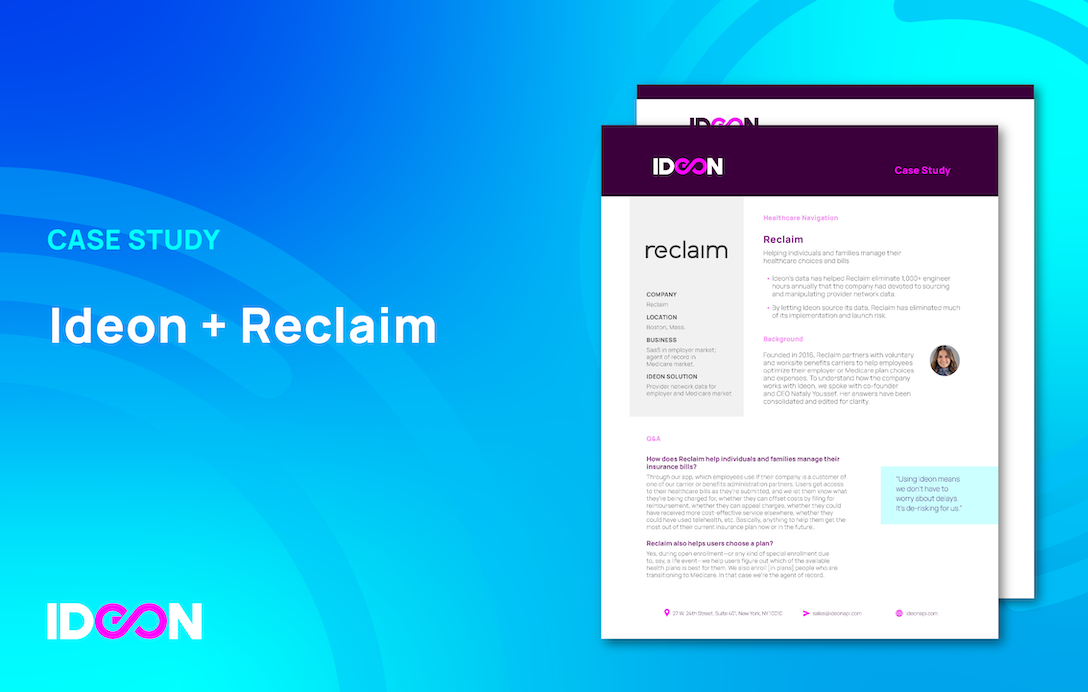“Ideon cleans up the big mess the industry has built”
With the agency management software Benelinx, employee benefits brokers access health insurance quotes from multiple carriers in a flash. The company was started by Rachel Zeman, who formerly ran a brokerage and was frustrated with the redundancies and errors that were par for the course in the space.
In contrast to the traditional, broken model, brokers using Benelinx’s quoting engine have to enter a client’s parameters just once to quote and compare medical plans from numerous carriers.
Backstage, Ideon’s APIs quietly power Benelinx’s quoting tool through seamless data exchange. (We’re the strong, silent type.)
Benelinx
Helping agencies compete nationwide.
- The Benelinx system, with data from Ideon, allows brokers to get accurate health insurance quotes from multiple carriers, saving hours on every proposal.
- Ideon makes it easy for Benelinx to expand into new states and offer additional products without the need to negotiate with and connect to additional carriers.
Background
Rachel Zeman built RiteHealth Solutions into a thriving benefits brokerage based in Boulder, Colorado In 2019, she sold that company and started Benelinx to offer other brokers access to the customized software platform she had built for her own firm. Benelinx relies on Ideon to make it easier for brokers to provide quotes that compare rates from multiple carriers.
Q&A
Tell us more about why you started Benelinx
When I ran a brokerage we had become increasingly frustrated with the industry’s archaic systems, which are littered with redundancies and errors that don’t make sense in the modern world. We’d ask, “Why do we have to enter the same client information five times into five different systems?” And there was never a good answer. So we decided to streamline the process and built applications on the Salesforce platform. I knew this was something the market needed and it wasn’t available.
What problems do brokers face getting quotes for health insurance?
Most agencies are still running their entire business on Excel spreadsheets. If they want to make a proposal for clients, they have to go to the websites of four, five, six carriers, and upload the employee census to each, then download a quote. Then they have to compare them because every carrier’s rates and requirements are different. The only practical alternative they had was to work with a general agent that had relationships with multiple carriers, but as brokers get larger they often want to bring more in-house.
How does Benelinx make that easier?
The broker just enters the parameters for a particular client and uploads the census one time. Then all we have to do is ping Ideon, and we get back everything that is available to the client based on each carrier’s underwriting requirements. Every time we demo the quote function to a broker they are blown away.
Why did you decide to use Ideon to power your quoting engine?
The only other option would be to go to all of the carriers directly. It would have been very painful. When we started, we tried to get carriers to give us their rates electronically, and most wouldn’t give us the time of day. If they did agree, the data they sent would have to be cleaned, verified, and put into a standard format. Every carrier uses its own system and way of transferring data. Ideon cleans up the big mess the industry has built.
Can you describe the experience of integrating Ideon into your system?
My developers would say they have had nothing but amazing support, starting when we were integrating Ideon into our system. The customer service was great, and all their technology was up-to-date.
What’s the biggest advantage of working with Ideon?
Ideon has made it easy for us to grow. They are adding new products, like level funded plans. That’s something our clients have been asking for so now we can plug it into our system. It’s so simple. We’ve also been able to expand nationally. If we didn’t have Ideon we would have to go state by state and convince every carrier to give us rates. I can’t fathom what that would look like.
How does your story fit into the broader industry picture?
Our industry is in the middle of a huge consolidation, and that makes it difficult for many brokers. There is nothing more important than maintaining boutique brokers that can help smaller-size businesses make complicated and expensive decisions about healthcare. Ideon is helping us offer a very affordable solution that lets brokers of all sizes compete.









